IRIS
Iris
Tourn. ex L., Sp. Pl. 38. 1753; Gen. Pl. 5: 24. 1754; Boiss., Fl. Or. 5: 117. 1882; Hook. f., Fl. Brit. Ind. 6: 271. 1892; R. R. Stewart, Ann. Cat. Vasc. Pl. Pak. & Kashm. 63. 1872; Ali & Mathew, Fl. Pak. @ eFloras.org Pakistan V 202.
Perennial herbs with rhizome, bulb or stolon. Aerial stem solitary or many, simple or branched, shorter or longer than leaves. Leaves mostly basal, 2-ranked, often oriented edgewise to aerial stem, flat, equitant, ensiform to linear, canaliculate, 4-angled or terete. Bracts (spathes or spathe valves) 2 or more, subtending 1 or more flowers. Inflorescence of rhipidia (cymose) arranged in racemes, paniculate or solitary. Flowers sessile or shortly pedicellate, white, yellow, violet or purple, relatively large, often fragrant. Perianth segments 6, connate at base with the hypanthium, forming a short to well developed tube (usually trumpet-shaped), dimorphic: outer 3 long, known as FALLS, usually differentiated into basal claw (glabrous or bearded ) and a lamina which may have a broad, cockscomb like crest, unicellular papillae or only a smooth ridge, lamina usually reflexed; inner 3 known as STANDARDS, smaller, erect or spreading, never ornamental; colour variations much pronounced: either whole flower uniformly coloured or bicolored, then FALLS normally darker. Stamens 3, attached to hypanthium opposite the FALLS, opposed to style branches and appressed to them, filaments free and flattened. Style branches 3, petaloid, each branch arched over the stamen and claw of FALL, bilobed at the tip; stigma is represented as a flap on the outer side of each style. Capsule globose, ellipsoid or cylindrical, apex beaked or not, many seeded. Seeds pyriform, flattened and D-shaped or irregularly angled, sometimes arillate.
311 species
Iris domestica
Iris domestica
(L.) Goldblatt & Mabb., Novon (15)1: 129. 2005; Belamcanda chinensis (L.) DC. in Redoute, Liliac. 3 (21): t.121. 1805; Fl. China @ eFloras.org 24: 312; Fl. North Amer. @ eFloras.org 26: 396.
Perennial evergreen herb, ca. 1 m tall; rhizomatous, rhizome creeping, horizontal, near ground level. Aerial stem well-developed, erect, 3-5-branched, leafy. Leaves cauline, 8-14 per stem, distichous, oriented edgewise to aerial stem giving fan-shaped appearance to plant; leaf blade 20-60 cm x 2-3 cm, glaucous, narrowly lanceolate or ensiform, midvein obscure, apex acuminate. Inflorescence panicle of rhipidia, each rhipidia 3-5-flowered, spathe 1-2 cm long, green, membranous distally. Flowers 3-4 cm across, radially symmetric, bisexual, orange to reddish coloured; pedicels slender, ca. 1.5 cm long. Perianth of 6 tepals in 2 whorls of 3 each, dimorphic, outer 3 large (FALLS), inner 3 small (STANDARD); tepals connate basally into perianth tube, tube short or vestigial; perianth segments ascending proximally, +/- spreading distally, light orange to reddish with large conspicuous, irregularly scattered spots of darker pigment. Perianth segments differentiated into basal claw and upper lamina: claws short or obscure, canaliculate adaxially or keeled abaxially, claws of FALLS filled with dark viscous fluid; lamina obovate with emarginate apex or elliptic, ca. 2.5 cm x 1 cm, outer ones somewhat larger. Stamens 3, inserted at base of outer perianth segments, 1.8-2 cm long, diverging; filaments 10-12 mm long, orange; anthers 6-8 mm long, oblong, diverging, not appressed to style branches. Ovary inferior, narrowly ovoid, 3-angled, 6-8 mm long; style 1, +/- equalling perianth segments, 3-angled proximally, thickened in distal half, 3-lobed at apex, flattened, lobes spreading; stigmatic distally.
Fruit not observed.
Common Names: Leopard Lily, Blackberry Lily, Leopard Flower
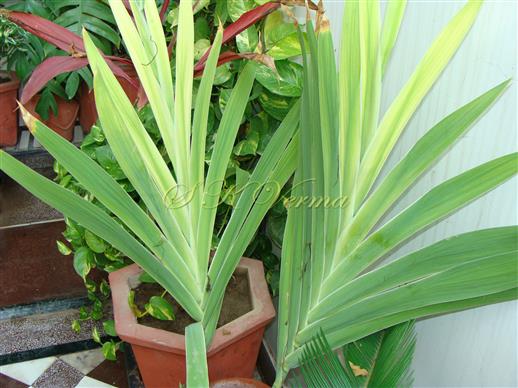
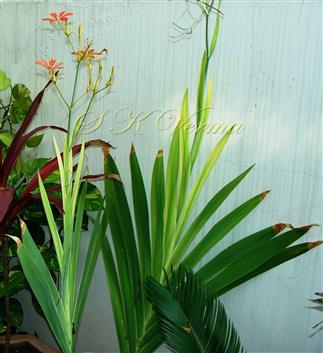
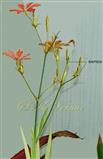
-9883 - Copy.jpg)
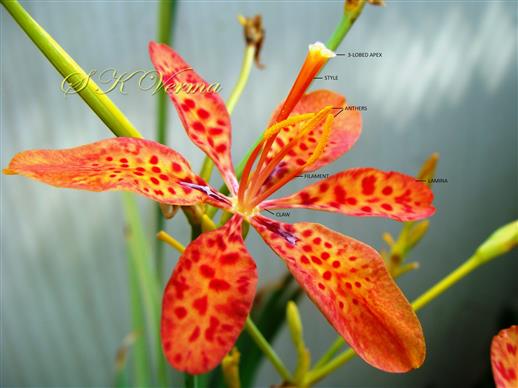
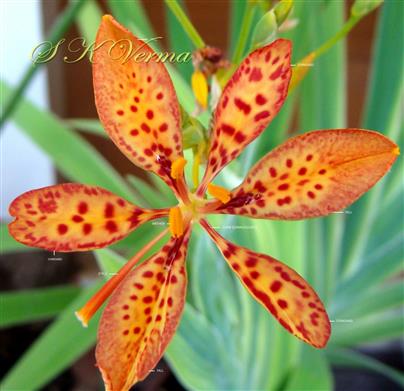
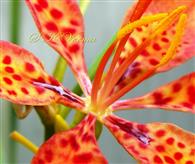




-9883 - Copy.jpg)


